Companies use SMS (short messaging service) to have two-way texting conversations with their customers. Texting is a powerful tool, yet SMS marketing strategies often fail because texting gets treated like “just another channel.” It’s not.
Texting with a customer is personal, immediate, and disruptive. These can all be good factors, but only if you have an appropriate SMS marketing strategy.
SMS Marketing Strategy Quick Links
Here’s what we’ll cover:
- Basics of SMS Marketing
- 5 Parts of Every Successful SMS Strategy
- 20 SMS Marketing Tactics – And When to Use Them
- Important SMS Marketing Metrics
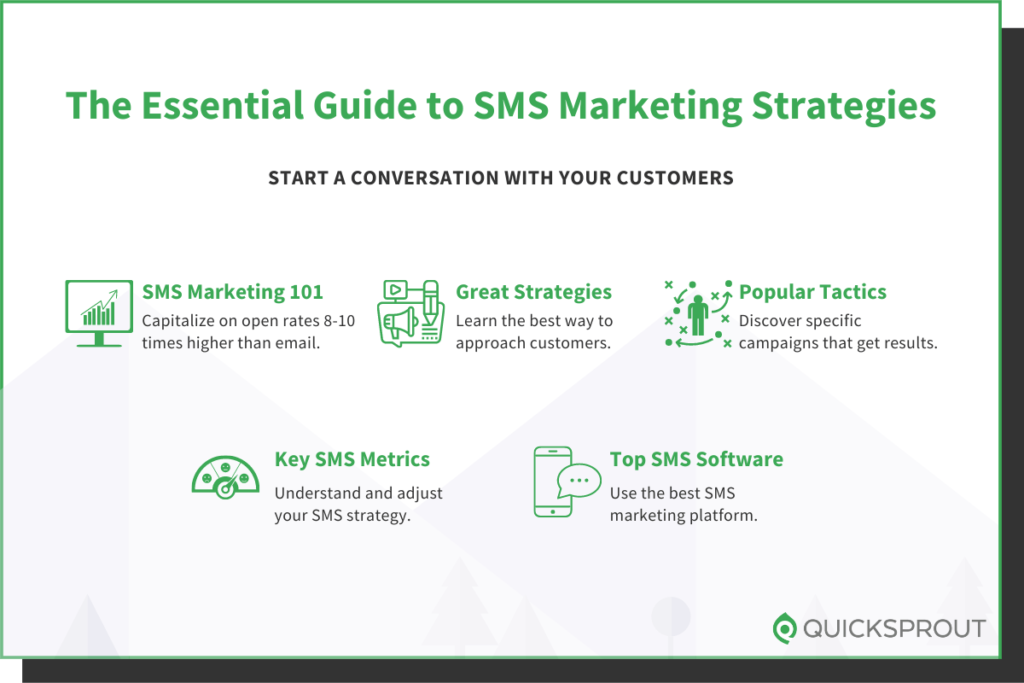
Basics of SMS Marketing
SMS marketing is the use of text messaging to communicate with your customers.
You’ll use trackable links and shortcodes in order to get customers into your system to start a two-way conversation.
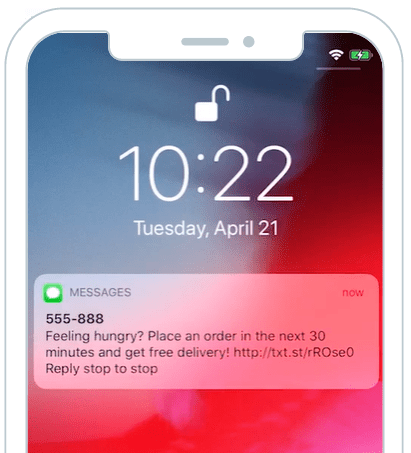
There are a lot of different ways you can use this channel to get new customers and refresh relationships with old ones.
As you consider various strategies for using SMS marketing, here are some key considerations:
- SMS marketing is permission-based. People have to formally opt-in for you to send them promotional messages via SMS. There are steep fines for companies that send SMS to people who haven’t opted in (or who have formally opted out).
- MMS is standard now. Older business texting services struggled with multimedia messaging service (MMS), which lets you text GIFs, emojis, and images. Today, any decent SMS marketing platform lets you send MMS, no problem.
- Opening this channel is a huge opportunity. SMS has a nearly 100% open rate, and it’s not even surprising. I check all my texts, and so do most people I know.
- SMS marketing is not email marketing: Texting is more personal and immediate than email will ever be. People are more receptive to texts, but also more turned off by texts they don’t want.
- Timing is critical. Who needs their phone buzzing on a nightstand at 3 AM to know their order has shipped? Yes, they opted in for text updates, but come on!
SMS marketing offers your company a powerful way to connect with customers, but it has to be approached in the right way. You have to be strategic about using such a potent channel.
5 Parts of Every Successful SMS Marketing Strategy
The ultimate goal of any SMS marketing strategy is to send the right message, to the right subscriber, at the right time.
It takes time and effort to get all three right. No single campaign or tactic is going to deliver messages that check all these boxes on day one. You need an overarching SMS marketing strategy that helps you determine the best use of your resources over time.
Now everyone reading this post is going to have different objectives, customers, and so on. You’ll have to be smart about the particulars of your industry, but here are the five most important factors that all successful SMS marketing relies on.
Note: I’ll be using SimpleTexting to provide visual examples of SMS in action. It’s as easy-to-use as it gets for a first-timer, and you’ll be able to send your first 50 texts for free (no credit card required).
1. Deliver Real Value to Subscribers
Permission-based marketing like SMS requires people to opt-in in order to receive texts. If you are serious about using this channel, getting the opt-in is more than just checking a box for regulators.
The goal is to offer real value to your customers. “Here’s a discount,” is nice, but you are still asking the consumer to come to your site and spend their money, even if they’re getting some savings.
Promo discounts and special offers are great, don’t get me wrong, but you can be smart about how you get people to take the first step:
- Offer concrete benefits: Give customers the option to receive order confirmations and updates via text. That’s a real benefit, and maybe they’ll opt-in for promotions as well. Also, consider sweepstakes and other “Text-2-Win” type contests where customers trade their contact info for a shot at a free prize.
- Sweeten the pot: Access to exclusive offers, gated content, loyalty programs, and newsletters are other great ways to offer more value to customers for opting in.
- Make it easy: The less of a chore it is to subscribe, the better. Make it as few clicks and questions as possible.
- Keep it toll-free: Let customers know that you’ll pick up the tab for the cost of the message with toll-free shortcodes and numbers.
- Offer a clear opt-out: this guarantees that people who don’t want to hear from you won’t, which saves everyone time. It makes your offer look more transparent and trustworthy, too, not like you’re trying to trick them
A good business text messaging service makes it easy to set up forms on your site, social media, or create catchy print advertisements. These tools help you stay compliant with texting laws, generate shortcodes, and keep track of campaigns.
Here’s a good example of a graphic built on SimpleTexting that would work well on a website or in real life.

Focus on making the experience better for consumers. Runners go through shoes frequently. One text a week makes sense for a runner looking to jump on a deal every once in a while.
“Text2Win” type campaigns can also be great for building your list. You’re offering entry into a sweepstakes for opting in. It doesn’t cost them anything to reach out and make that first connection with your brand.
2. Warm the Channel
When I give my number to someone, I don’t want to receive a flood of text messages. Maybe we’ll start texting a lot over time, but it probably won’t be zero-to-sixty. The same is only more true if I give my number to a brand.
SMS is a channel that you really have to warm. If the goal is to be conversational, you have to “text with people,” not text at them.
One of the most common ways to get the ball rolling is to set up a short welcome series of texts using an autoresponder.
In this example from SimpleTexting, an autoresponder is configured to offer a special deal to customers for signing up immediately after they opt-in.
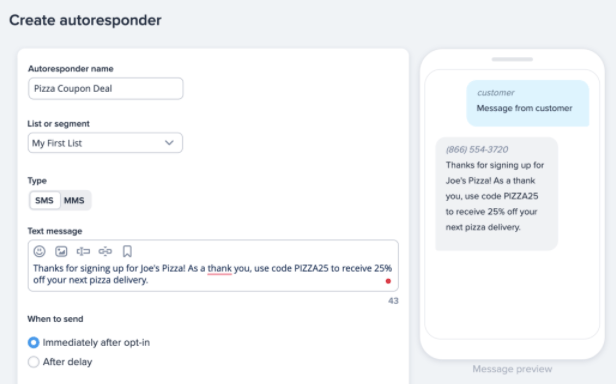
From here, you extend your welcome series with more discounts, special perks, and access to exclusive content. You can also use the opportunity to educate your customer about your offerings and increase brand awareness.
A basic welcome campaign is usually 3-5 texts spaced out over a few weeks. With premium SMS services, you’ll be able to use autoresponders to start gathering information about your customers that can help you target your offers better.
In this example, you can see the beginning of a short welcome series after someone has opted in by texting “Bookworm.”
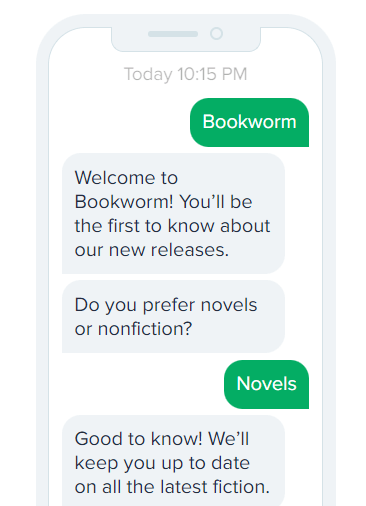
There’s a short welcome text followed by a short question to get some basic data about this customer’s preferences.
“Novels” is quite a large category, so you can’t send them glass-slipper fit recommendations yet. But you have certainly started to warm the channel using a conversational feel.
If setting up multi-level autoresponders seems like too much work, don’t underestimate the value of simple texts to keep the ball in the air. The following post-purchase text is a great example of keeping the channel warm:
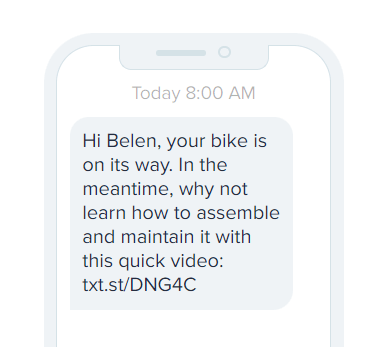
This short text confirms their order and invites them to check out content that you know is relevant to them based on their purchase. This delivers value and keeps someone connected to your brand without having to set up a full welcome campaign.
3. Set Clear Expectations
Texting is all about instantaneous responses. So if you put it out there that your company is going to be reachable by text, then you had better be able to respond quickly.
People may expect that the ability to “text with your brand” means that they can get customer service on-demand. Do you have the staff to support that? It’s fine if you don’t, just be transparent with customers about what to expect.
Going back to the opt-in advertisement from SimpleTexting, you can see how the terms are clearly stated:

All that this company is promising is a weekly text. There’s nothing in this offer that says the company is going to be reachable 24/7.
I don’t think too many people would be shocked to receive only automated texts after opting in on that text. And autoresponders and chatbots are an important part of any large-scale SMS strategy. They can do wonders to prevent business-owner fatigue at managing simple questions.
But chatbots can’t fully create the “conversational” and “two-way” experience that customers expect via SMS. So if you have the staff to put customers in touch with a human, great. If you don’t, make sure that you are not promising customers more than you can deliver by opening up SMS as a channel.
If this offer read something like, “Questions? Text RUN to 900900,” some customers would likely expect more of an authentic conversation—with a real person on the other end of the text conversation. The last thing you want to do is set up a situation where your customers feel like they have to fool a chatbot in order to speak with a real person. We’ve all been there, and it’s really frustrating.
My advice is to use automation to your advantage. Setting up automated replies for after-hours messages, for example, can ensure you and the customer stay on the same page. They get an instant response that lets them know exactly what to expect:
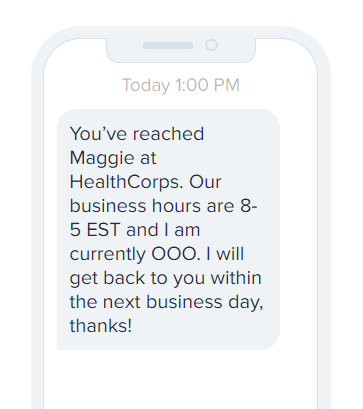
This is a basic example, but you should always be thinking about how you can communicate boundaries and expectations with your customers.
4. Get to Know Your Customers
As part of your conversational SMS strategy, you will have many opportunities to learn more about your customers: who they are, what they like, dislike, and so on. All of this is incredibly important information that you can use to better target your offers.
Likely, you grabbed a little bit of info from people when they opted in to receive texts, but it’s just the basics. You don’t want to make it too tedious to sign up.
I’d recommend using Urchin Tracking Module (UTM) parameters, which are code snippets attached to the end of the links you share with customers. UTM parameters are free to use through Google Analytics, and let you track where leads are coming from.
This way you can find out which outreach strategies are bringing in the most new customers. UTM parameters may also be able to pick up a person’s email, zip code, and other information that could be useful.
Over time, you should reach out to find out more, logging all this information in your CRM software or SMS platform.
If you are using a platform like SimpleTexting, you can easily build questions, surveys, and polls to get a better sense of what people really think.
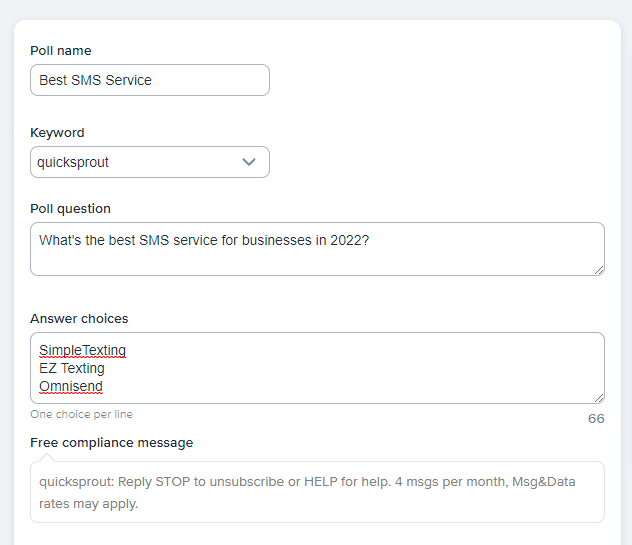
It’s not complicated in the slightest to set one of these polls up, and you can tie them to a specific keyword or campaign.
Then you send it out to the appropriate group and wait for the data to roll in.
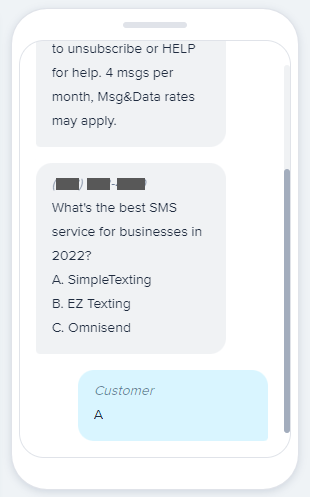
You can keep the conversation going by sharing results with subscribers, posting the results on your social media, or running another poll based on what you discovered.
Do what you can to know your customers, and remember the answer. If someone checks that their preference is vegetarian, make sure you’re not sending them deals on steak dinners.
5. Segment Subscribers to Personalize Offers
With the information you have about your customers, you can start to segment them into different groups. If you’re unfamiliar with this concept, check out this article I wrote on generational marketing that explains the basics of segmentation.
The goal is to deliver content and offers that are relevant to specific customer segments. You want to approach a frequent buyer differently than a first-timer, for example. Or you might have products for seniors that you don’t want to market to young buyers.
Segmentation is using what you know to target the right people. In this example from SimpleTexting, you can see how a text is only going to be sent to a specific segment: only subscribers in Beverly Hills, CA, 90210.
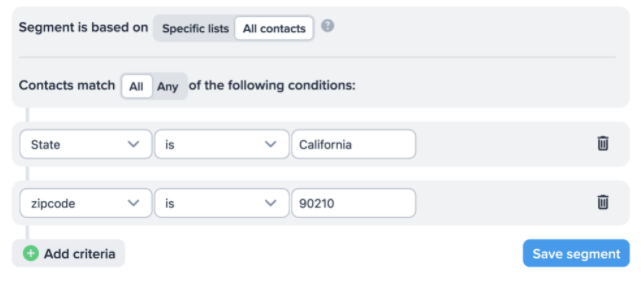
This is a really basic example, but you can see how you could set up the segmentation criteria based on any information you have: age, interests, gender, location, and much more.
You might send a special offer to everyone who has bought something within the last week to capitalize on the post-purchase high. Or send a more exploratory text to all subscribers that haven’t purchased anything in 90 days.
Automating these tasks isn’t hard either. You could create triggers that would send an SMS seven days after a purchase, or after 90 days of account inactivity.
If you have an online store, you can set up a lot of automated triggers based on how people shop. The main criteria for segmenting users in an online store are:
- Browsing behavior: Did the customer look at certain types of products? This can tell you a lot about a person’s taste, what they are really interested in, and what they are likely to ignore.
- Buying behavior: Has the customer bought before, and if yes, how much and how often? Typically, a huge chunk of a company’s sales come from a relatively small percentage of loyal customers.
- Location: What is the customer’s time zone and zip code? This will help you pace your offers to arrive at an appropriate time of day. Knowing the local weather of a zip code can help retailers market certain goods to people who really need them.
The better job you do learning about and segmenting your customers, the more targeted and personalized you can get with your SMS marketing strategy.
20 SMS Marketing Tactics – And When To Use Them
Now that we have an understanding of the big-picture strategy to win the hearts and minds of your customers, it’s time to drill down into the tactics you can use to put your strategy into action.
There are a million ways to use texting to connect with customers–here, I’ve listed 20 of my favorite SMS marketing tactics.
Instead of listing them in one long run, I’ve grouped them by objective, starting with tactics for getting people to opt-in and become subscribers.
Of course, you can use tactics at different times with good results, but these groups will be helpful if you are just starting off.
SMS Tactics for getting more subscribers
People have to opt-in to receive texts. Here are some of my favorite ways to get potential customers to initiate the conversation:
- Sweepstakes: People will “Text-2-Win” if it’s something they want.
- Social campaigns: Share great offers and time-sensitive deals across groups and channels mesh with your market.
- Gated content: Trading access to premium content for contact information is a win/win
- Referral programs: Reward your subscribers for inviting new ones
- Order tracking: People want to receive texts about the status of their purchase, so see if they’ll accept promotional texts as well.
- Free shipping: Waive the charge if people opt-in to receive texts.
- Pop-ups: Put a simple form with your offer in front of every website visitor.
- VIP Access: Give someone access to special benefits or exclusive offers by becoming a VIP subscriber.
Focus on delivering more than just a discount. What is gated content your type of customer would really want? What product could you give away in a sweepstakes that would grab people’s attention? What kind of exclusive access will make someone feel like a VIP?
In this example from SimpleTexting, texting the keyword “Pawprint” automatically enrolls a subscriber in a VIP text club. Now they can get exclusive offers on products every pet owner needs.
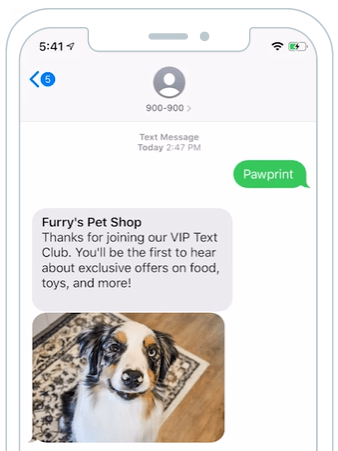
SMS tactics for nurturing leads
Once someone has opted in, you’ll want to warm up the channel and entice subscribers to engage more with your brand. Here are a few ultra-successful SMS tactics for building that all-important connection:
- Welcome campaigns: Onboard your customers and educate them about what you offer. Delight them with free content and get them to want to know more.
- Loyalty programs: Give people a way to earn exclusive gifts, prizes, or redeemable points on every purchase or $1 spent.
- Drip campaigns: Send a series of scheduled messages to get people responding. Trigger different events based on responses.
- Weekly updates: One text a week with tips, insights, or special deals can keep the channel warm without overwhelming your subscribers.
- Special events: Whether you invite people to your physical store or a digital event like a webinar, text invitation gatherings can really build a sense of community with your brand.
Find a cadence that works, and use segmentation to make sure you’re communicating the right way with the right customer. Some subscribers may want a lot more attention, whereas others may only want to see the absolute hottest deals.
Not every text has to sell something, either. Update your subscribers about big company milestones and where your brand is headed.
This brief text from SimpleTexting invites subscribers to watch an interview with the CEO. Sharing such “insider” content is a great way to get people to feel like they are part of your brand.
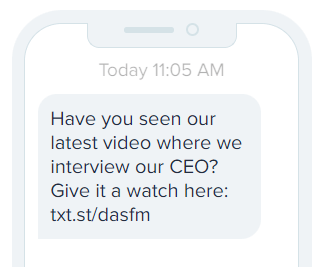
SMS tactics for driving conversions
A solid SMS strategy takes advantage of how immediate text messaging is. The average person reads a text between 1-3 minutes after receiving it, and often responds just as quickly.
Here are some great ways to create a moment worth seizing:
- Post-purchase followup: Tap into that post-purchase high to offer another product they almost bought, or ask them to leave you a public review.
- Time-sensitive offers: Alert subscribers to incredible deals and steals that won’t be around tomorrow.
- Holidays and Anniversaries: Reward someone on their birthday or one-year anniversary of being a subscriber. Holiday-themed offers work really well, too.
- Abandoned cart: Reach out to see if they are still interested in the items they selected but didn’t follow through on purchasing.
- New product release: Invite subscribers to check out the latest and greatest that your company offers.
- Back-in-stock notifications: Use a person’s purchase history to update to let them know the out-of-stock item they wanted is now available.
- Geofencing: Send a text to people who walk by your store or arrive in a very specific area.
You can get really, really crafty with these tactics, especially if you’ve done the backend work of segmenting your audience.
That said, you don’t need to set up elaborate marketing automation software or geofencing to find success with SMS. Don’t underestimate the power of a simple SMS offer delivered at a sensible time.
The following example from SimpleTexting is something any restaurant could find success with:
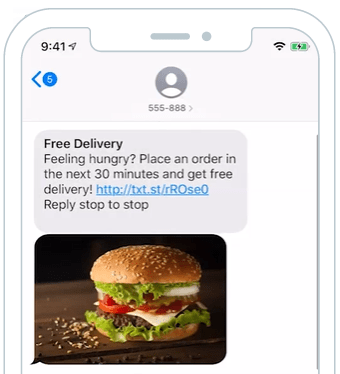
Important SMS Marketing Metrics
It’s crucial to be able to see how well your SMS marketing strategy is performing. If revenue is going up, great, but you still want to know why. The goal is to identify which specific tactics are working well, and which you might want to change.
Here are the essential metrics you need to know in order to assess how your SMS strategy is progressing:
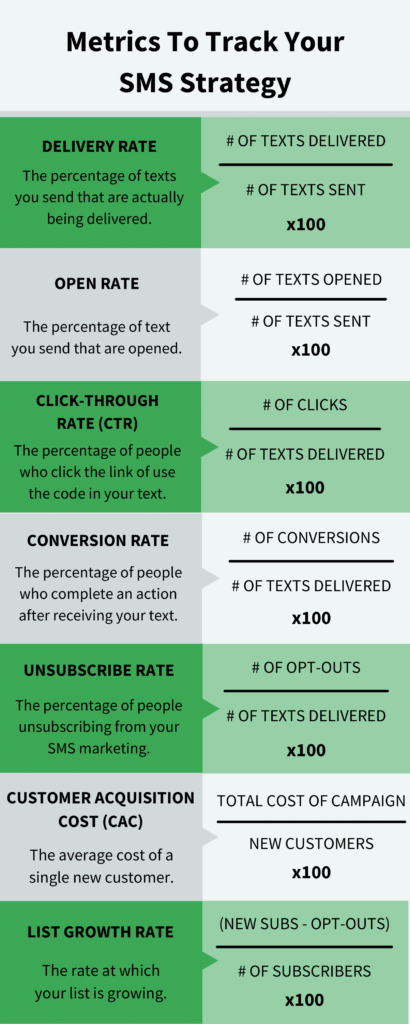
How to Use SMS Metrics to Improve Performance
Knowing these metrics can help you pinpoint problems. Your delivery rate should be close to 100%–if texts are failing to send or not getting delivered, there are some technical issues you need to address right away.
Anticipate that your open rate is going to be really high with SMS. If you are coming from email marketing, you may be blown away by getting an SMS open rate of 90% or higher–sorry, but that’s just SMS.
If you’re not getting a high open rate with SMS, then you might want to think about who you are sending these offers to, and how you are building your list. Are you really reaching out to the right folks?
Similarly, if you get a high click-through rate (CTR), but your conversion rate is super low, it might be time to switch up your offer. What can you do to sweeten the pot for people who were interested enough to click through but not enough to convert?
Your list-growth rate is going to tell you a ton about how successful your SMS strategy is. Break this number out across campaigns to see which ones are the most successful at retaining customers, and apply those tactics to areas where you’re seeing a higher unsubscribe rate.
When you use an SMS marketing platform like SimpleTexting, it’ll calculate these metrics for you, and allow you to view trends over the last week, month, billing cycle, or campaign:
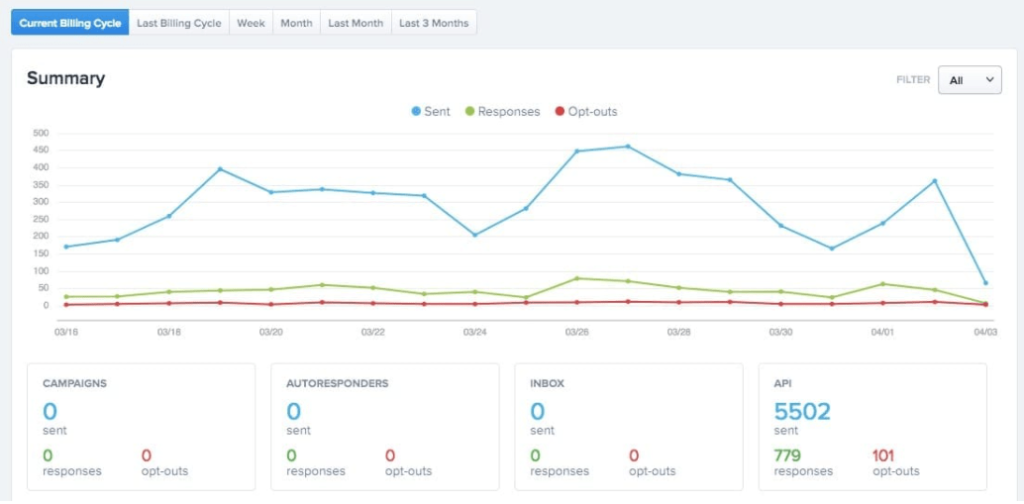
With this kind of visibility into performance, you can see which campaigns are working well, and which ones need to be tweaked.
And because you can break out this data by billing cycle, you can get a real-time read on your customer acquisition costs (CAC). This number is important to track, and you can lower it by increasing the subscribe and conversion rates.
So long as you have a good estimate for the average lifetime value of your customers, you can subtract the CAC to get an idea of the kind of incentive you can offer. How much can you really sweeten the pot before it gets too expensive?
You can also drill down into the specifics of a campaign. See how many people subscribed via each link or opted out. SimpleTexting automatically calculates the CTR for each link:

I strongly encourage you to try out a variety of approaches and tactics. Engage in A/B testing to see what types of offers find traction with your audience.
In this example from SimpleTexting, you can see how half of the subscribers get a 10% discount and the other half get free shipping:
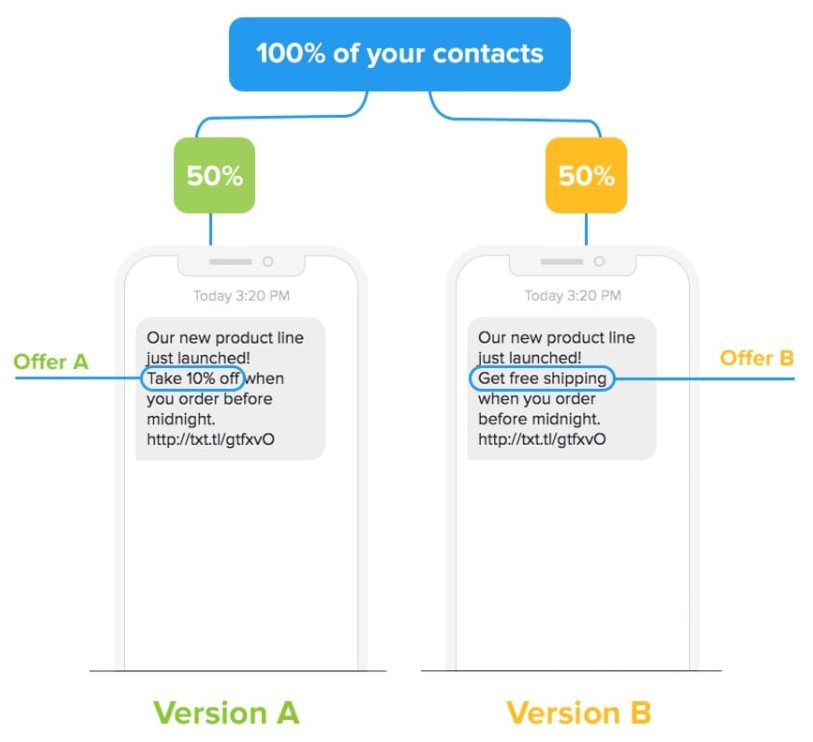
At the end of the A/B test, you’ll want to look at things like the CTR, conversion rate, and unsubscribe rate. It should be pretty obvious which offer is performing better, and that tells you how to pitch the next round of SMS.
If more people respond favorably to your free shipping offer, then that’s a sensible play to make with future subscribers.
Knowing how your SMS campaigns are performing will let you find incremental gains that compound over time. Each small win counts, and the more wins you can find, the more success your SMS marketing will have.
Summary
SMS marketing is an affordable and effective way to reach consumers, but it’s hardly a turnkey solution. The speed and intimacy of the channel provide a unique opportunity, and with a thoughtful SMS marketing strategy, you can take full advantage.
We’ve covered the basics of SMS marketing, the crucial parts of every successful strategy, and 20 tactics you can use to start campaigning today. We also looked at the key SMS metrics that will help you capitalize on success and steer away from failure.
All that’s left to do is launch your first SMS campaign. Good luck!
from Quick Sprout https://ift.tt/FpbMwzr
via IFTTT
